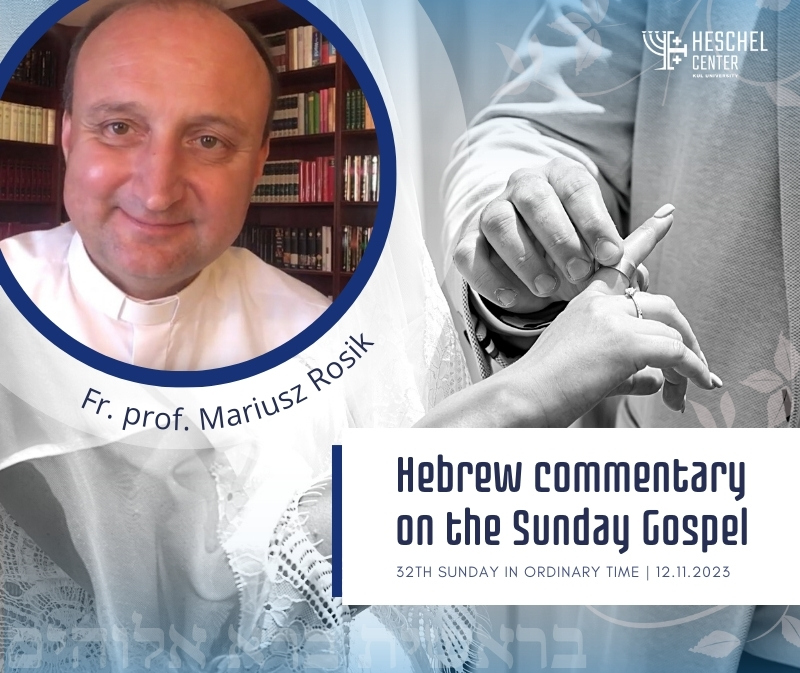Who were the virgins in Jesus'''' parable at the Jewish wedding?
 Learning about Jewish wedding customs can help you understand the parable of the Wise and Foolish Virgins. Jesus describes the moment when the bridegroom and his friends set out for the bride's house, and her friends go out to meet them, explains biblical scholar Fr. Prof. Mariusz Rosik in a commentary for the Heschel Center of the Catholic University of Lublin for Sunday, November 12. He stresses that Jesus, referring to the Jewish wedding tradition, calls for readiness and vigilance for his second coming at the parousia.
Learning about Jewish wedding customs can help you understand the parable of the Wise and Foolish Virgins. Jesus describes the moment when the bridegroom and his friends set out for the bride's house, and her friends go out to meet them, explains biblical scholar Fr. Prof. Mariusz Rosik in a commentary for the Heschel Center of the Catholic University of Lublin for Sunday, November 12. He stresses that Jesus, referring to the Jewish wedding tradition, calls for readiness and vigilance for his second coming at the parousia.
The knowledge of Jewish wedding traditions is the key to understanding Jesus' parable of the wise and foolish virgins. On the eve of the nuptials in the evening, the groom and his friends would go to the bride's father's home. "Dressed in ceremonial robes, he headed the procession, accompanied by male friends. Chants were then performed, largely based on the text of the Song of Songs," the biblical scholar points out. "The bridesmaids from the bride's home came to meet the bridegroom while the bride was still under her father's protection," he adds. The two retinues would then meet halfway, proceeding together to the bride's home.
As Fr. Rosik points out, Jesus' parable of the wise and foolish virgins concerns the moment when the groom arrives at the bride's house, and her friends come out to meet him. "Night is approaching, so they must have their lamps lit; they are olive lamps. Then, some of the bridesmaids realized they were running out of oil. When they went to the city to refill the oil in their lamps, the bridegroom came and closed the doors of the wedding house," the biblical scholar explains. Only in this context does the explanation and message of the parable become eloquent. "This is how Jesus calls us to look forward to His second coming at the Parousia, in an attitude of readiness, expression of which is a lit lamp," concludes Fr. Mariusz Rosik. "The oil in the lamps here can be a symbol of the good deeds to do in anticipation of the day of the parousia," he adds in conclusion.
Heschel Center of the Catholic University of Lublin
We publish the entire text of the commentary:
In ancient Israel, marriage was based on a contract, which had to be accompanied by a written document. The formula for entering into marriage sounded more or less like this: "She shall be my spouse, and I shall be her husband, from this day forward until eternity." On the eve of the nuptial day, the groom and his friends would go to the bride's father's house. Clad in ceremonial robes, he proceeded to head the procession, accompanied by his male friends. Chants were then performed, which were primarily based on the text of the Song of Songs. The bridesmaids from the bride's home came to meet the bridegroom while the bride was still in the care of her father. The two retinues would meet halfway and head to the bride's home together.
The bride, clad in a veil, was brought in during the chanting, and the trek to her husband's house began. Upon arrival, the groom's parents would utter the blessing formula. The party then began, in which the bridegroom took an active part. The bride remained with her friends in a separate room. The next day was filled with parties, usually entertained in two rooms, the men and the women separately. A festive meal was also served separately. Shortly after that, the bride would take her place under a canopy called a chuppah, and, surrounded by her friends dressed in white, she would receive her gifts. When this joyous moment was over, the groom would arrive, praising the bride's charms. It was then that the most solemn moment of the nuptials occurred. It usually took place in a very romantic setting. Well, the bride and the groom would pour one cup of wine together, and having drunk the wine, they would smash the cup against the threshold. The moment when the cup hit the ground was considered the definitive moment of marriage. Wedding feasts usually lasted about seven days.
Jesus' parable is about that moment when the groom and his friends set out for the bride's house, and her friends come out to meet them. The night is approaching, so they must have their lamps lit; they are olive lamps. Then, some of the bridesmaids realized they were running out of oil. When they went into town to refill the oil in their lamps, the bridegroom arrived and closed the doors of the wedding house. It is how Jesus calls us to look forward to his second coming at the parousia in an attitude of readiness, which is to be expressed by a lit lamp. The oil in the lamps here may symbolize the good deeds to do in anticipation of the day of the parousia.
About the Author: Fr. Prof. Mariusz Rosik is a biblical scholar, professor of theological sciences, director, and researcher of the Institute of Biblical Studies at the Pontifical Faculty of Theology in Wrocław. He specializes in the New Testament's theology, the Synoptic Gospels' exegesis, and ancient Jewish history. Author of numerous scientific, popular science, and pastoral publications. Websites: www.mariuszrosik.pl www.lumenvitae.pl
Abraham J. Heschel Center of the Catholic University of Lublin












